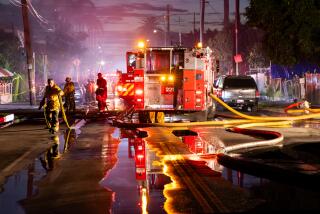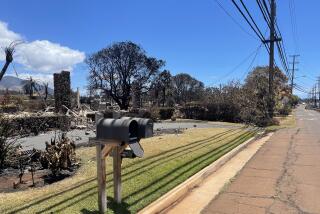Small spark can mean disaster for home

The Haroutounians set off for their home on Big Horn Mountain Way confident it had survived the firestorm.
They had a barrel tile roof, boxed eaves, brick and stucco siding. They had just cut down three trees near their house and cleaned out the rain gutters. And a wide street and a line of other large luxury homes separated their Yorba Linda property from the brush wild lands of Chino Hills State Park.
But their hearts sank when they turned onto their block Sunday afternoon. Of the 18 homes on their side of the street, only two had burned. One was theirs.
“I’m glad that my neighbors’ houses survived,” said Hamlet Haroutounian, 47.
“But it bothers me: Why my house?”
The answer was something they never thought of: the humble attic vent.
“An ember settled right there and got into the insulation,” said Capt. Bill Lockhart of the Orange County Fire Authority, pointing to the gable vent on a still-standing wall. “I can guarantee it. It’s almost out of a textbook.”
He said the mesh covering the vent had quarter-inch holes. Fire marshals now recommend eighth-inch mesh.
For 50 years, fire authorities have told homeowners in fire-prone areas to get rid of shake roofs and to clear brush, and people have gradually heeded the advice.
These days, the devil is hidden in the smallest of details.
“There will be a weak link in the house that is destroyed,” said Stephen Quarles, an advisor at UC Cooperative Extension and an expert in how homes catch fire.
He said it is usually not raging flames that ignite a home, but an ember slipping through a small breach: a vent, a doggie door, a gap under the garage door, an open window, a cracked roof tile.
Fires like the one that raged through north Orange County last weekend, destroying 113 homes in Yorba Linda, spew billions of embers into the air -- some as small as an apple seed. Santa Ana winds drive those burning projectiles horizontally for hundreds of yards, pelting homes far from the flame front. Just one ember getting through a crack could spell destruction.
“The biggest thing that causes these homes to burn is ember intrusion,” said Chip Prather, chief of the Orange County Fire Authority. “You’ve got hurricane-force winds pushing embers toward houses.”
The goal is to seal off the home like a ship to the sea and prepare for a leak where it is most likely to occur.
People don’t think of the newspapers awaiting recycling in their garage, or old boxes in the attic, or dried-up birds’ nests in the arches of roof tiles.
State rules in effect since July 1 are meant to address this. Builders in fire-prone areas are required to screen attic vents, cover eaves, use non-flammable planks for decks, install tempered glass in windows so they don’t shatter when heated and close the gaps under barrel tiles with mortar or a piece of material called a bird stop.
The rules do not require homeowners to update existing homes. And even compliance with the new code doesn’t guarantee safety.
Wood mulch, patio furniture and trash cans ignite next to the house. Wind pushes piles of burning debris against doorjambs.
Ornamental plants catch fire, and then crack a window or send a flume of embers into an attic vent. Even lush, well-watered foliage dries up in the searing wind and becomes a fire hazard.
In an analysis of last year’s Witch fire in San Diego, federal researchers determined that embers were a leading cause of destruction.
Of 74 homes that burned in the Trails neighborhood of Rancho Bernardo, only 19 were next to the flaming front of the wildfire.
Embers destroyed the rest -- either by starting a spot fire next to the homes (in at least 35 cases) or by directly entering the home (in at least 20 cases), according to the Building and Fire Research Laboratory of the National Institute of Standards.
The study confirms what firefighters have been seeing for years.
Michael Boyle, a battalion chief with the Orange County Fire Authority, came upon a Yorba Linda resident who had stayed Saturday to defend his home. Boyle saw wood patio furniture scattered about the backyard.
“I told him to throw it in the swimming pool, and he did,” he said. “A few hours later the house was still standing.”
Boyle and other firefighters pointed to another culprit: palm trees.
With their lattice of dead and dry material, they light up instantly and unleash blazing debris like an arc welder.
“Many times I saw people wetting down their roofs,” Boyle said. “Don’t waste your time on the roofs; point your hose at the palm fronds over there.”
One firefighter said he spent the good part of a day pulling fallen, burning palm fronds away from garage doors.
On Ridge Park Drive in Yorba Linda, Michael Landig watched palm trees carry the fire from property to property.
“The neighbors’ palm trees were just exploding,” he said, “and we were running and getting ladders and getting hoses and putting out the palm trees. That was the first thing that caught in every instance.”
He watched the paint on the house next door start bubbling. Soon the glass windows exploded and the home burst into flames.
When one home goes down, its neighbors’ are much more likely to burn, too. While wildfires roar through in minutes, a house fire can last for an hour, radiating enough heat to ignite curtains and blinds through the windows of the homes next door.
Fortunately, Landig’s home survived.
Hamlet Haroutounian acknowledged the fire captain’s explanation of why his home burned. The exterior walls of the home were still standing, but the inside was destroyed, clearly from the attic down.
“It’s hard to accept,” he said.
The homes on Big Horn Mountain Way were all built in the early 1990s to the same standards. Of 35 homes on the street, 27 remain standing. And 11 of those are, unlike his property, right against the wild land.
But at least one of Haroutounian’s neighbors had taken extraordinary precautions.
When the fire roared up to Michael Bishop’s house, his girlfriend flipped a switch and nozzles began spraying Phos-Chek fire retardant all over the side of his house, coating even his plants.
Bishop, a 50-year-old emergency room doctor, installed the system for $15,000, which can be activated by phone if no one is home to turn it on.
“We’re very conscious of the fact that there’s a fire risk here,” he said. “All it takes is one ember.”
Barboza, Abdollah and Mozingo are Times staff writers.
More to Read
Start your day right
Sign up for Essential California for news, features and recommendations from the L.A. Times and beyond in your inbox six days a week.
You may occasionally receive promotional content from the Los Angeles Times.








